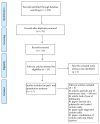Antimicrobial Activity of Cerium Oxide Nanoparticles on Opportunistic Microorganisms: A Systematic Review
- PMID: 29607315
- PMCID: PMC5827881
- DOI: 10.1155/2018/1923606
Antimicrobial Activity of Cerium Oxide Nanoparticles on Opportunistic Microorganisms: A Systematic Review
Abstract
An evaluation of studies of biologically active nanoparticles provides guidance for the synthesis of nanoparticles with the goal of developing new antibiotics/antifungals to combat microbial resistance. This review article focuses on the physicochemical properties of cerium oxide nanoparticles (CeNPs) with antimicrobial activity. Method. This systematic review followed the Guidelines for Transparent Reporting of Systematic Reviews and Meta-Analyses. Results. Studies have confirmed the antimicrobial activity of CeNPs (synthesized by different routes) using nitrate or chloride salt precursors and having sizes less than 54 nm. Conclusion. Due to the lack of standardization in studies with respect to the bacteria and CeNP concentrations assayed, comparisons between studies to determine more effective routes of synthesis are difficult. The mechanism of CeNP action likely occurs through oxidative stress of components in the cell membrane of the microorganism. During this process, a valence change occurs on the CeNP surface in which an electron is gained and Ce4+ is converted to Ce3+.
Figures


Similar articles
-
A rapid and systematic review of the clinical effectiveness and cost-effectiveness of paclitaxel, docetaxel, gemcitabine and vinorelbine in non-small-cell lung cancer.Health Technol Assess. 2001;5(32):1-195. doi: 10.3310/hta5320. Health Technol Assess. 2001. PMID: 12065068
-
Adefovir dipivoxil and pegylated interferon alfa-2a for the treatment of chronic hepatitis B: a systematic review and economic evaluation.Health Technol Assess. 2006 Aug;10(28):iii-iv, xi-xiv, 1-183. doi: 10.3310/hta10280. Health Technol Assess. 2006. PMID: 16904047
-
Cost-effectiveness of using prognostic information to select women with breast cancer for adjuvant systemic therapy.Health Technol Assess. 2006 Sep;10(34):iii-iv, ix-xi, 1-204. doi: 10.3310/hta10340. Health Technol Assess. 2006. PMID: 16959170
-
A rapid and systematic review of the clinical effectiveness and cost-effectiveness of topotecan for ovarian cancer.Health Technol Assess. 2001;5(28):1-110. doi: 10.3310/hta5280. Health Technol Assess. 2001. PMID: 11701100
-
Local anti-infective therapy: pharmacological agents. A systematic review.Ann Periodontol. 2003 Dec;8(1):79-98. doi: 10.1902/annals.2003.8.1.79. Ann Periodontol. 2003. PMID: 14971250
Cited by
-
Photo-inactivation of bacteria in hospital effluent via thiolated iron-doped nanoceria.IET Nanobiotechnol. 2019 Oct;13(8):875-879. doi: 10.1049/iet-nbt.2019.0149. IET Nanobiotechnol. 2019. PMID: 31625530 Free PMC article.
-
Topical gel-based biomaterials for the treatment of diabetic foot ulcers.Acta Biomater. 2022 Jan 15;138:73-91. doi: 10.1016/j.actbio.2021.10.045. Epub 2021 Oct 30. Acta Biomater. 2022. PMID: 34728428 Free PMC article. Review.
-
Cerium Dioxide Particles to Tune Radiopacity of Dental Adhesives: Microstructural and Physico-Chemical Evaluation.J Funct Biomater. 2020 Feb 11;11(1):7. doi: 10.3390/jfb11010007. J Funct Biomater. 2020. PMID: 32053986 Free PMC article.
-
Lanthanides-Substituted Hydroxyapatite/Aloe vera Composite Coated Titanium Plate for Bone Tissue Regeneration.Int J Nanomedicine. 2020 Oct 27;15:8261-8279. doi: 10.2147/IJN.S267632. eCollection 2020. Int J Nanomedicine. 2020. Retraction in: Int J Nanomedicine. 2021 Sep 24;16:6535-6536. doi: 10.2147/IJN.S340619. PMID: 33149574 Free PMC article. Retracted.
-
Vat Photopolymerization of CeO2-Incorporated Hydrogel Scaffolds with Antimicrobial Efficacy.Materials (Basel). 2025 Mar 2;18(5):1125. doi: 10.3390/ma18051125. Materials (Basel). 2025. PMID: 40077350 Free PMC article.
References
-
- Sievert D. M., Ricks P., Edwards J. R., et al. Antimicrobial-resistant pathogens associated with healthcare- associated infections: summary of data reported to the national healthcare safety network at the centers for disease control and prevention, 2009-2010. Infection Control and Hospital Epidemiology. 2013;34(1):1–14. doi: 10.1086/668770. - DOI - PubMed
-
- Wisplinghoff H., Ebbers J., Geurtz L., et al. Nosocomial bloodstream infections due to Candida spp. in the USA: species distribution, clinical features and antifungal susceptibilities. International Journal of Antimicrobial Agents. 2014;43(1):78–81. doi: 10.1016/j.ijantimicag.2013.09.005. - DOI - PubMed
Publication types
MeSH terms
Substances
LinkOut - more resources
Full Text Sources
Other Literature Sources
Molecular Biology Databases

